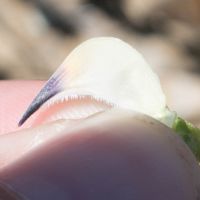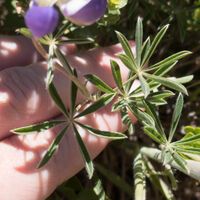varied lupine
Lupinus variicolor
Member of
lupines (genus Lupinus)
legume family (family Fabaceae)
dicots (class Magnoliopsida)
blue, purple, pale purple, yellow, cream, white in flowering plants



- habit: perennial herb, subshrub, 20–50 cm, generally dense-appressed or -spreading-silver-hairy
- stem: prostrate to decumbent, not weak
- leaf: cauline, often appearing clustered near base 1st year; stipules 7–8 mm; petiole generally 4–10 cm; leaflets 6–9, 20–35 mm
- inflorescence: 6–15 cm, flowers ± whorled or not; peduncle 4–12 cm; pedicels 4–12 mm; bract 4–7 mm
- flower: 11–16 mm; calyx upper lip 7–8 mm, 2-toothed, lower 8–9 mm, generally entire; petals white, yellow, rose, or purple, often on 1 petal, banner back glabrous, spot 0
- keel upper margins ciliate, lower glabrous
- common along pacific coast and east bay from Chabot north
Toxicity of blue bonnet, lupine (Lupinus spp.):
4 – Ingestion of these plants, especially in large amounts, is expected to cause serious effects to the heart, liver, kidneys or brain. If ingested in any amount, call the poison center immediately.
Locations: Months: For more details, use advanced search.
Chris’s observations: 4 (1 is research grade)
Taxon info: iNaturalist – Calflora – CalPhotos – Jepson eFlora – FNA
Bay Area species: iNaturalist – Calflora